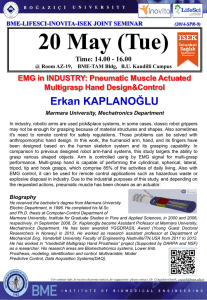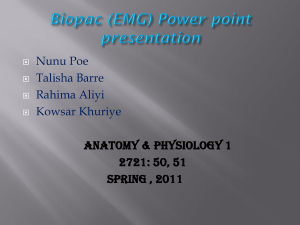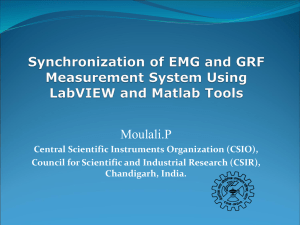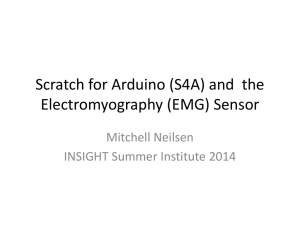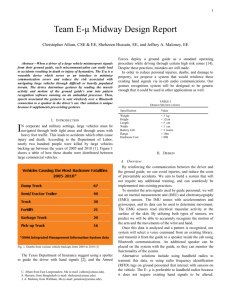Inertial Sensor Subsystem
advertisement
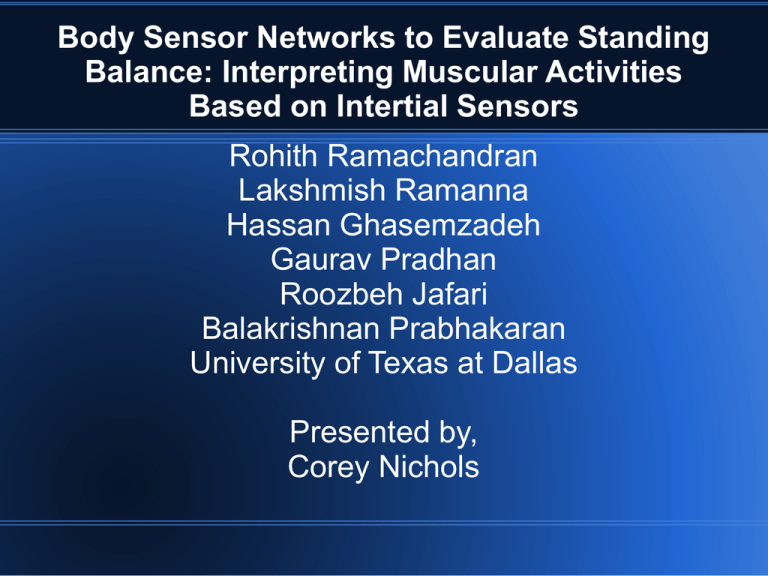
Body Sensor Networks to Evaluate Standing Balance: Interpreting Muscular Activities Based on Intertial Sensors Rohith Ramachandran Lakshmish Ramanna Hassan Ghasemzadeh Gaurav Pradhan Roozbeh Jafari Balakrishnan Prabhakaran University of Texas at Dallas Presented by, Corey Nichols Introduction Why interpret muscle activities for balance performance based on intertial sensors? – Rehabilitation, sports medicine, gait analysis, & fall detection all can make use of a balance evaluation. – Inertial sensors currently in use, but do not measure muscle activity directly – Measuring muscle activity may provide additional info Goal – Investigate EMG signals to interpret standing balance – Use inertial sensors to help interpret these signals Balance Parameters [1] Mayagoitia, R.E., et al., Standing balance evaluation using a triaxial accelerometer. Gait and Posture, 2002. 16: p.55-59. Parameters are classified as low, medium, and high Want to analyze EMG signals to make the same classifications using Linear Discriminant Analysis (LDA) – LDA: Method in statistics and machine learning to find a linear combination of features that best separates multiple classes of objects or events (source: wikipedia) Evaluation Model Uses the Balance Evaluation Model from [1] – Uses a single accelerometer – • Height of the center of mass Build and trace an acceleration vector Building and tracing an Acceleration vector Building and tracing an Acceleration vector • • • Combined Acceleration: A= a 2x a 2y a 2z Directional angles using Cartesian Coordinates: = arccos a x / A , = arccos a y / A , = arccos a z / A D is the combined coordinates in all three directions: cos = − d z / D , d x = Dcos , d x = Dcos Quantitative Features • Total Distance: D t = ∑ n= startpoint endpoint dy − dy n 2 n 1 dx − dx n 2 n 1 • Mean Speed: s m= D t /t • 2 r = 1/ N d Mean Radius: m ∑ n= startpoint x • Mean Frequency: f m= D t / 2 • Anterior/Posterior Displacement: d a/ p = max d d − min d d endpoint n d 2y n rm xn ∀ n ∀ n Medial/Lateral Displacement: d m/ l = max d d − min d d ∀ n yn ∀ n yn xn Quantitative Features System Architecture Inertial Sensor Subsystem EMG Sensor Subsystem Balance Platform Inertial Sensor Subsystem Body sensor network of two nodes – A tri-axial 2g accelerometer • – – Samples at 40Hz Base station • Collects data over wireless channel • Relays info to PC via USB Sensor data is collected and processed using MATLAB EMG Sensor Subsystem • Four EMG sensors used – Measures electric activity generated by muscle contractions – Electrodes acquire EMG signal – Sample at 1000Hz – Signal is amplified and band-pass filtered to 20-450Hz – Data is transferred to a PC and processed off line Balance Platform • Balance ball (half sphere w/ standing platform) – Use a level to control the experiment or for coaching Signal Processing Feature Analysis Five stages of operation – Data Collection – Parameter Extraction – Quantization – Feature Extraction on EMG – Feature Analysis Signal Processing Feature Analysis Data Collection – Parameter Extraction – Accelerometer & EMG signals recorded every 4 seconds Extract 5 quantization factors using the accelerometer data Quantization – Classify data into 'low', 'medium' and 'high • Within 1 std. Dev. of the mean implies 'medium' Signal Processing Feature Analysis Feature Extraction on EMG – Obtain an exhaustive set of statistical features from the EMG signals • Signal Energy, Maximum Peak, Number of Peaks, Avg. Peak Value, and Average Peak rate Feature Analysis – Using LDA, extract significant features from EMG signals – Determine if the EMG signals are representative of the quantitative features for balance evaluation from the accelerometer Experimental Procedure • Subjects: – 5 males aged 25-32 and 1.65-1.8m tall with no disorders – Wore the accelerometer on a belt around the waist with the sensor positioned in the back. – 4 EMG electrodes attached on the lower leg • Right/Left-Front (Tibalis Anterior muscle) • Right/Left-Back leg (Gastrocnemius muscle) Experimental Procedure • Sensors: – Delsys “Trigger Module” allows the EMG to work sychronously with the accelerometer – MATLAB tool sends the trigger • To EMG through the trigger module • To accelerometer through USB – MATLAB tool analyzes the data – Data was recorded every 4 seconds Experimental Procedure • Test Conditions: – Nine test conditions – Two trials per condition Experimental Results • 90 trials performed • Classifies each trial into 'low', 'medium', & 'high' qualities – Done for each accelerometer parameter – Each EMG feature is assigned the same quality label as its corresponding accelerometer data Experimental Results • Made EMG signals representative of performance parameter for balance evaluation – Used 50% of trials to find significant features – The remaining trials were for evaluation of the system – Extracted 5 signals from each of the four EMG – Form a 20 dimensional space that is representative of some muscle activity properties – LDA is used to select the most prominent feature from the subset Experimental Results • Uses the k-Nearest Neighbor classifier to determine the effectiveness of the EMG features • K-NN classifies objects using training examples Questions? Related Work • A lot of work has been done based on human performance and quality of balance • A study on children compared EMG with kinetic parameters for balance responses shows that muscle activities contribute to balance • This is the first work that uses inertial sensors to help interpret EMG signals Conclusion & Future Work • Uses acceleration and muscle activity data to perform an analysis during standing balance • Break the accelerometer data down into five metrics • Prominent features are extracted from EMG signals using the accelerometer data to evaluate the balance • Future goals: – Integrate a “gold standard balance system” with their experiments – deploying a system that performs the data processing in real-time
